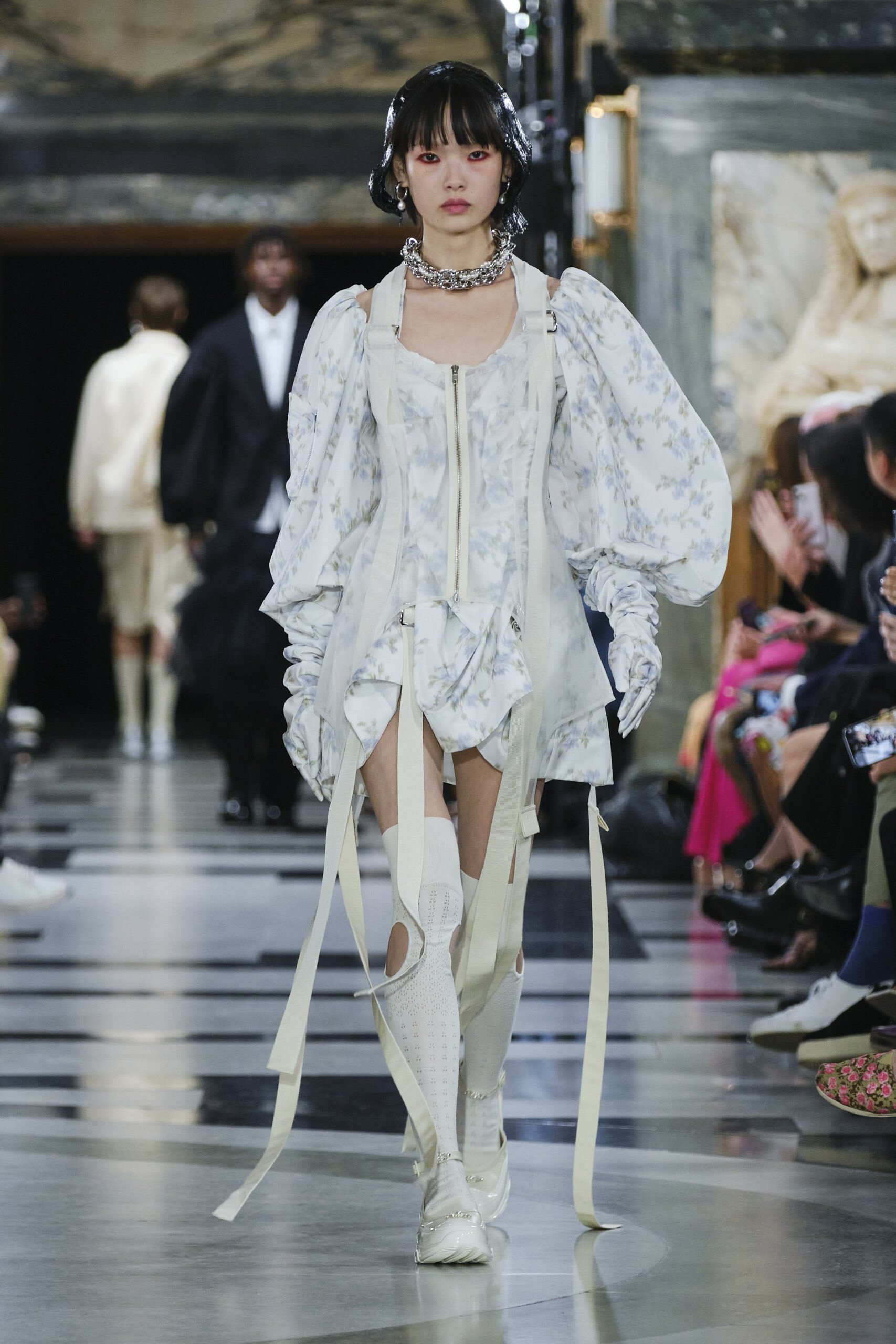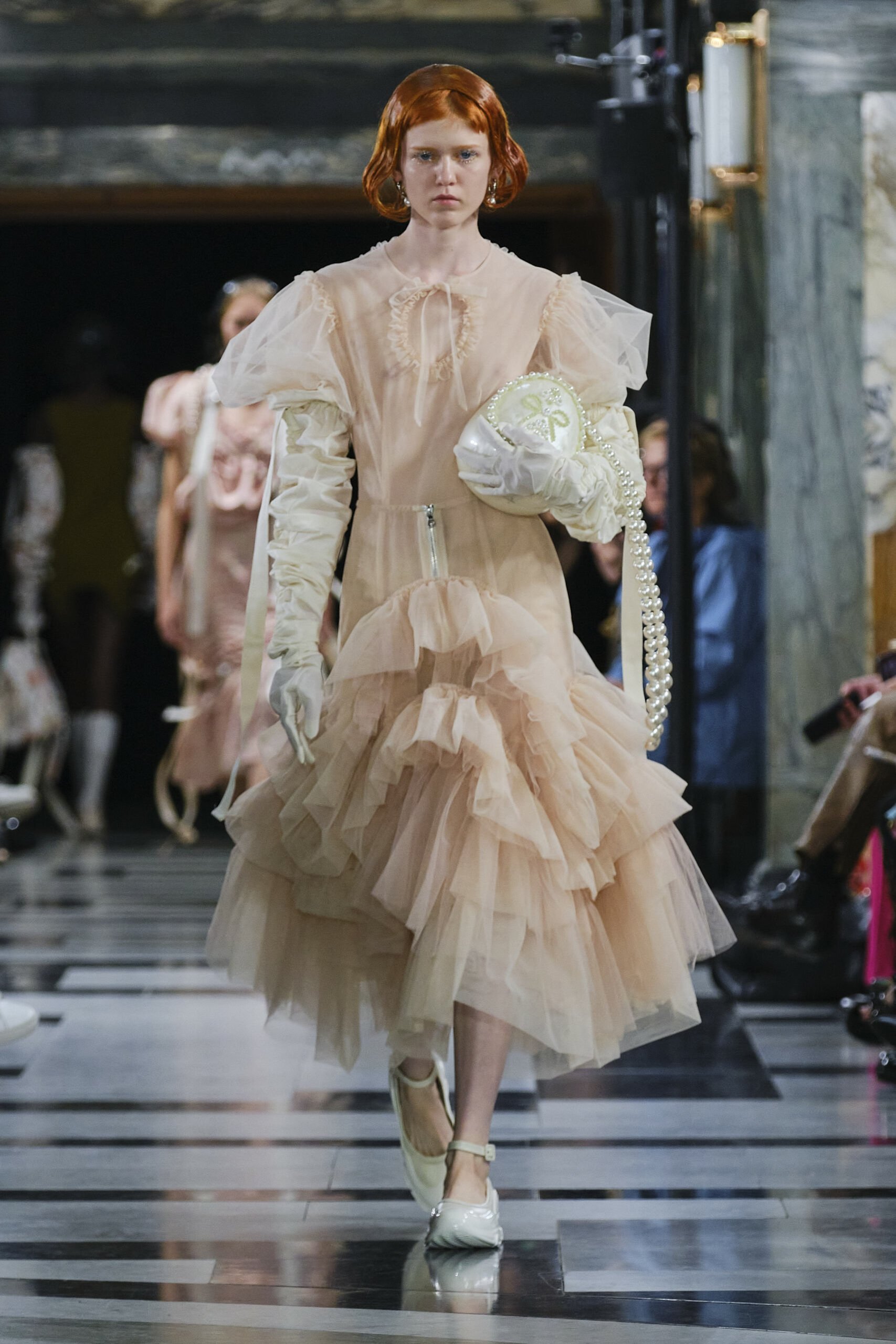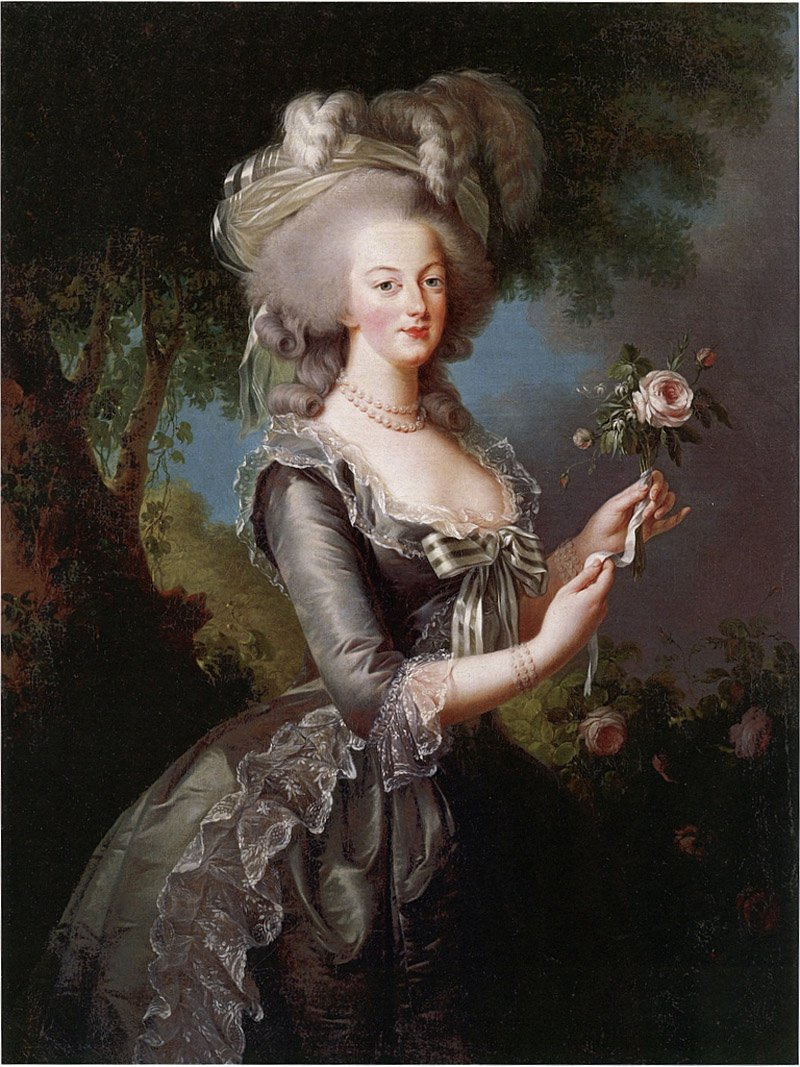Before there were Influencers: How a portrait of Marie-Antoinette radically transformed the European textile industry
By Claire Ferguson
The debut of Simone Rocha’s Spring 2023 ready-to-wear collection this fall illustrated once again the designer’s steadfast Rococo influence. Rocha’s latest capsule included motifs such as floral prints, pearl accessories, and exaggerated form. Killian Quigley, in Matter and Meaning in the Rococo Undersea (2019), explains that the movement’s nomenclature, ‘Rococo,’ originates from rocaille, a French term referring originally ‘to the pseudo-natural arrangement of shells, rocks, and stones…’ Simone Rocha’s aesthetic, therefore, through its affinity for nautical elements and ultra-feminine fabrics, recalls the sensuality and playfulness of the late-baroque period.
Filippo Fior (Gorunway.com), Runway look 39/48. Model: Xie Chaoyu for Simone Rocha’s Spring 2023, 2022 (source: Vogue Magazine)
Filippo Fior (Gorunway.com), Runway look 8/48. Model: Marie Kippe for Simone Rocha’s Spring 2023, 2022 (source: Vogue Magazine)
The designers’ art historical influence is by no means unusual in the fashion industry. The romanticization of eighteenth-century European opulence is a recurring theme on the runway. Marie Antoinette, one of the biggest fashion icons in history, has served as inspiration for many twenty-first-century collections, including Moschino Fall/Winter 2020 and Chanel Resort 2013. Moschino creative director Jeremy Scott spoke on the inspiration behind the autumn collection for L’Officiel, explaining that she serves as a model for the conceptual comparison of the French Revolution and today’s political climate. The collection, which utilized motifs such as cake icing, alludes to the extravagance of the French monarchy. On the other hand, Karl Lagerfeld’s Cruise collection for Chanel, presented at the Palace of Versailles in 2013 was a clear celebration of the Queen’s frivolous lifestyle.
While the French Queen continues to serve as a source of style inspiration today, she was a much more central figure in the eighteenth century. Her styling choices were heavily disseminated throughout Europe. In 1783 the Queen appointed Élisabeth Louise Vigée Le Brun to complete her portrait upon the artist’s admission into the Académie Royale de Peinture et de Sculpture. This resulted in the debut of Vigée Le Brun’s Marie Antoinette in a Chemise Dress, (1783). The composition is muted, portraying the Queen wearing a simple garment and straw hat, and holding a pink rose with a ribbon. Controversially, she is not presented in the typical royal manner.
Élisabeth Louise Vigée Le Brun, Marie Antoinette en Chemise, 1783, oil on canvas, 92.7 x 73.1 cm, The National Gallery of Art, Washington D.C
Filippo Fior (Gorunway.com), Runway look 64/67. Model: Joan Smalls for Moschino Fall/Winter 2020, 2020 (source: Vogue Magazine)
Vigée Le Brun’s monarchial portrait was originally titled La Reine à Gaulle. Gaulle refers to a casual muslin garment, which was traditionally worn by white colonists in the French West Indies. The painting now widely refers to Marie Antoinette’s garment as a chemise. This modification likely reflects public reception at the time of the portrait’s debut. The Queen, having opted for a far less lavish dress, was thought to have been wearing merely an undergarment, or chemise. The painting, having circulated by way of printed publications such as Galerie des Modes and Mémoires Secrets, became a breeding ground for the vilification of the monarch. Mémoires Secrets, complained of the images’ supposed display of ‘distinguished persons wearing garments reserved for the intimacy of the palace.’ The royal was known to have been criticized by the French public for her opulent lifestyle and exorbitant spending habits. Even having gained the moniker ‘Madame Deficit,’ she was often the source of public outrage. In addition to existing rumors of promiscuity and extramarital affairs, the garment in Marie Antoinette’s portrait served as a source of public controversy.
The Academy overwhelmingly disapproved of Vigée Le Brun’s work. The Queen’s chemise, in all its simplicity, was deemed inappropriate for a monarch's portrayal. The fashion choice, alongside Vigée Le Brun’s neglect to identify the sitter in the work’s original title, was considered a suppression of the Queen’s royal standing. The reaction forced the artist to remove La Reine à Gaulle and conjure another portrait in its place, one which portrayed the royal in formal attire.
Élisabeth Louise Vigée Le Brun, Marie-Antoinette with a rose, 1783, oil on canvas, 87 x 130cm, Palace of Versailles
Although Vigée Le Brun removed the portrait quickly following response from the Academy, its impact had already taken place. The material of the garment was problematic as, consisting of muslin imported from England, threatened French textile production. The influence of Marie Antoinette in eighteenth-century Paris, especially among the nobility, could not be overstated. Her modeling of a gaulle in Vigée Le Brun’s portrait directly coincided with a plummet in the demand for silk in France. Desperate to compete with Britain’s industrial production, France, seeking to increase cotton production, turned to the colony of Saint-Domingue. As William H. Sewell Jr. explains in The Empire of Fashion and the Rise of Capitalism in Eighteenth-Century, (2010), ‘by the 1780’s, white muslin cotton dresses, in the bucolic style made famous by Marie-Antoinette, became the height of fashion.’ Furthermore, Jane Ashelford, in ‘Colonial livery’ and the chemise à la reine, 1779–1784, (2018), elaborated on this dramatic shift in the European textile industry. Ashelford explains that just one year after the unveiling of La Reine à Gaulle, ‘In 1784, 24,000 [enslaved persons] arrived in Saint-Domingue, rising to 41,000 in 1790.’
The completion of Marie Antoinette’s portrait, which uniquely displayed a muslin gaulle, directly coincided with an exponential surge in the production of cotton to keep up with European demand. The Queen’s garment, having caused such negative implications, serves as a warning of the hyper-manic consumption that surrounds present fashion cycles. Improvement in technology has seen the dissemination of style shift from traditional artistic production to social media. Modern celebrities can serve as catalysts, as the Queen did, to hasten production and imitation. Unethical fast-fashion labels such as PrettyLittleThing, Boohoo, and SHEIN will continue to rely on this influencer-to-follower relationship as long as we allow it. Vigée Le Brun’s La Reine à Gaulle heeds powerful implications, prophesying the rapid response of modern consumer culture.
Notes:
Ashelford, Jane. “‘Colonial livery’ and the chemise à la reine, 1779–1784” in Costume, Vol.52, No.2 (September 2018): pp. 217-239.
Blanks, Tim. “Chanel Resort 2013.” Vogue Runway, May 13, 2012. [Accessed 10 December 2022] https://www.vogue.com/fashion-shows/resort-2013/chanel/slideshow/collection
Cohen, Hallie. “Bring ‘It’ Back, but Now Call It ‘Fast Fashion” in Cardozo Arts & Entertainment Law Journal, AELJ Blog, Vol.194 (March 2019)
Martin, Meredith. “Marie-Antoinette and the Hameau Effect” in Dairy Queens: The Politics of Pastoral Architecture from Catherine de Medici to Marie-Antoinette (Cambridge, Massachusetts: Harvard University Press, 2011): pp.158–213.
Mower, Sarah. “Simone Rocha: Spring 2023 Ready-To-Wear.” Vogue Runway, September 19, 2022. [Accessed 10 December 2022] https://www.vogue.com/fashion-shows/spring-2023-ready-to-wear/simone-rocha
Quigley, Killian. “The Porcelaneous Ocean: Matter and Meaning in the Rococo Undersea.” in The Aesthetics of the Undersea, edited by Margaret Cohen and Killian Quigley (London: Routledge, 2019): pp.29-30.
Segatti, Ana Lívia. “Moschino makes reference to Marie Antoinette in Fall 2020 Collection.” L’Officiel, March 10, 2020. [Accessed 10 December 2022] https://www.lofficielbaltic.com/en/fashion-week/moschino-makes-reference-to-marie-antoinette-in-autumn-2020-collection-in-milan
Sewell Jr. William H. “The Empire of Fashion and the Rise of Capitalism in Eighteenth-Century France” in Past & Present, No.206 (February 2010), pp. 81-120
The National Gallery of Art. “Marie-Antoinette, after 1783.” [Accessed 10 December 2022] https://www.nga.gov/collection/art-object-page.46065.html





